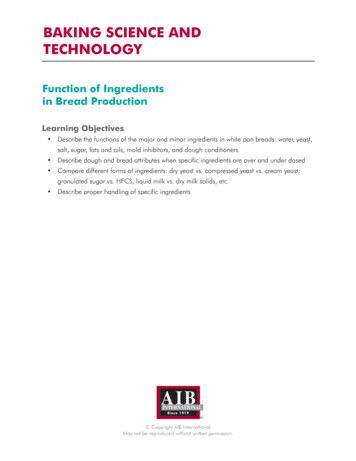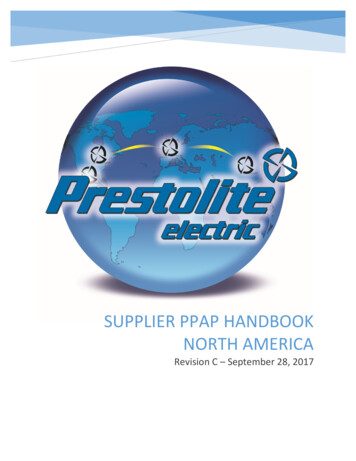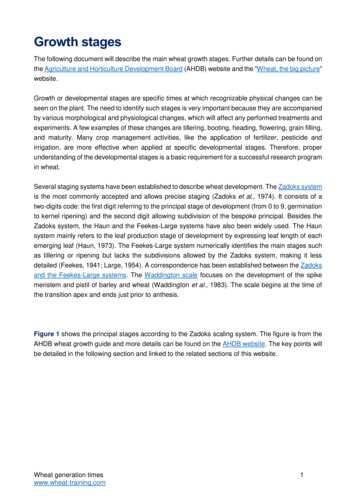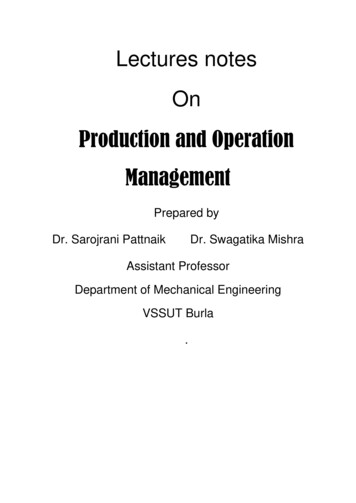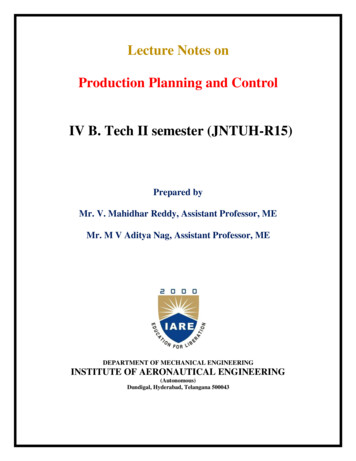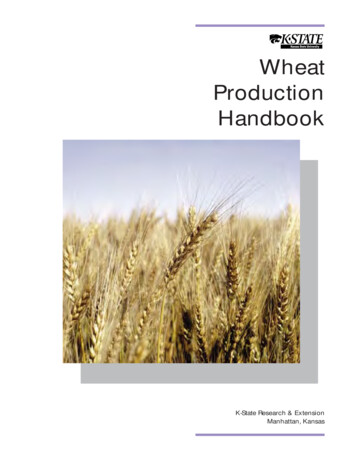
Transcription
WheatProductionHandbookK-State Research & ExtensionManhattan, Kansas
ContentsGrowth and DevelopmentGary M. Paulsen, Crop Research Physiologist, Agronomy2VarietiesRollin G. Sears, Wheat Breeder, Agronomy7Planting PracticesJames P. Shroyer, Extension Specialist, Crop ProductionHans Kok, Extension Specialist, Soil and Water ConservationCurtis R. Thompson, Extension Specialist, Crops and Soils, Southwest9Nutrient ManagementDavid A. Whitney, Extension State Leader, Agronomy12Weed ManagementDallas E. Peterson, Extension Agronomy, Weed Specialist15Disease ManagementRobert L. Bowden, Extension Specialist, Plant Pathology18Insect ManagementH. Leroy Brooks, Extension Specialist, Entomology25Irrigation ManagementDanny H. Rogers, Extension Irrigation Engineer, Biological and Agricultural Engineering29Harvest SuggestionsRandal K. Taylor, Extension Specialist, Farm Power and Machinery, Biological and Agricultural EngineeringMark Schrock, Farm Power and Machinery Researcher, Biological and Agricultural Engineering31Storage ManagementRandall A. Higgins, Extension Specialist, EntomologyJoseph P. Harner III, Extension Agricultural Engineer,Carl Reed, Extension Specialist, Grain Science and IndustryGeorge Lippert, Extension Specialist, Entomology, Southeast34Profit ProspectsLarry N. Langemeier, Extension Agricultural Economist-Adm. K-MAR-10538Brand names appearing in this publication are used for product identification. No endorsement is intended, nor is criticism of similarproducts not mentioned. Persons using such products assume responsibility for their use in accordance with current label directions ofthe manufacturer.More information about wheat can be found on the Wheat Page on the worldwide web at: http://www.ksu.edu/wheatpage/1
Growth and DevelopmentThe Turkey hard red winter wheat brought to Kansasby Mennonites in 1874 quickly became the mostimportant crop in the state. Continued improvements bybreeding and modern technology for production havekept Kansas the number one wheat state in the nation.Hard red winter wheat has stayed important for so longbecause its traits and pattern of growth and developmentare best suited of all crops to the weather, soils, and otherconditions in the state. However, weather in Kansas isless than ideal for wheat and, more than any other factor,limits grain yields in the state. Wheat growers in Kansasare highly knowledgeable and the soils are generallyexcellent, but grain yields are only a fraction of the 100plus bushels per acre averages in some countries. Theweather also limits the production inputs — the seedingrate, fertilizer, and pesticides — that can be usedeconomically for high Kansas wheat yields.What are the plant traits that enabled Turkey wheatand its successors, our present varieties, to become soimportant in Kansas? No single trait has been identified,and a combination of many different characteristicsseems to be involved. Winter wheat is a cool-season cropand grows best under moderate temperatures, but it isable to resist both cold and hot weather. This hardiness isessential for wheat to endure the freezing temperatures ofwinter, the late frosts of spring, the high temperatures ofJune, and the droughts that can occur anytime. Becauseof its winter growth habit, wheat is planted during fall,becomes well established before winter, and “greens up”and starts growing quickly when conditions are favorablein spring. Winter wheat not only resists freezingtemperatures during winter, it needs the cold to joint andflower so it can set grain in spring. Flowering alsorequires the lengthening days of spring, so it doesn’toccur until May, when the dangers of late frosts areusually past. The root system of winter wheat extendsfarther than that of any other wheat class, enabling theplant to obtain moisture from deep in the soil profile intimes of drought. These growth and development traitsmake wheat highly adaptable to Kansas conditions.The planting date is only one of the manymanagement practices that are determined by the growthand development patterns of wheat. The seeding rate, forinstance, sets the number of plants per acre and, alongwith tillers per plant, kernels per tiller, and weight perkernel, determines the yield of grain. A change to any ofthese yield components, such as a reduction in thetillering capacity, would change the seeding rate that isneeded for maximum production.By knowing how a wheat plant grows and develops,an understanding of why it responds as it does tomanagement and the environment can be gained. Thispublication tells how the wheat plant grows anddevelops. It also discusses some of the critical factors inits development at different stages of growth.Growth Stages from Germinationthrough MaturationThe growth and development of winter wheat aredivided into stages. Germination leads to seedlings, thefirst stage of plant growth, followed by tillering,overwintering, jointing, boot, heading, and flowering.Maturation, or development of the grain, is divided intomilk, soft dough, hard dough, and physiological maturity,the stage when kernel weight is maximum. Ripening, thelast stage, occurs as the grain loses moisture until it isready to harvest.Germination and Seedling EmergenceQuality seed is essential for establishing a productivestand. Seed should have at least 85 percent germinationand 56 pounds per bushel test weight and should not beshriveled. Large seeds have little, if any, advantage overnormal, plump seeds when both are planted at equalvolume or weight.A wheat seed begins germination by absorbing waterand oxygen. Adequate soil moisture and temperature areneeded for this to occur. Two parts of the wheat seed are ofgreatest importance in germination. The embryo, or“germ,” gives rise to the radicle, or the seedling root, andthe scutellum, or the first leaf. The other important part ofthe seed is the endosperm, which contains food in the formof starch and protein for germination and emergence.The coleoptile, or second leaf, penetrates the soil andresults in emergence of the seedling, usually within 5 to 7days after planting. If the seed is planted too deeply,beyond the elongation distance of the coleoptile, seedlingscannot emerge and a poor stand will occur. Semidwarfwheat varieties form short coleoptiles as well as shortplants, and planting depth is particularly critical for them.A firm seedbed assures good contact between theseed and the soil. Inadequate soil moisture is probablythe major reason for planting seed deeply. If the soilmoisture runs out before the seedlings emerge, as canhappen after light rains, survival of the seedlings oftendepends more on the stage of germination than the lengthof the dry period. Seedlings from seeds that havegerminated for only one or two days can survivedesiccation and resume growth when moisture reoccurs,but seedlings that are 4 or 5 days old probably will nottolerate drying.2
also undergo a change from an upright to a prostrategrowth form. Hardiness usually is greatest during earlywinter and is lost gradually as the season progresses.Most winterkilling occurs during late winter, when warmspells cause the plants to loose hardiness and then arefollowed by cold fronts that cause the damage. Snowprovides excellent protection because it insulates theplants from extreme cold and keeps them fromresponding to warm spells. The critical plant part is thegrowing point, which is protected partially by beingabout 1 inch below the soil surface during winter. Theentire plant is killed by injury to the growing point,which turns from a white, turgid appearance to a brown,wilted appearance after it is frozen. Leaves often staygreen during mild winters, but freezing or “burning” ofleaves by cold has little effect on yield.The first roots on the wheat seedling are known asprimary or seminal roots and include the radiclepreviously mentioned. Primary roots are usuallytemporary in wheat, unless the other roots fail to developbecause of poor conditions. Only the main stem of awheat plant has primary roots, which may be retainedthroughout the life of the plant. Most of the root systemthroughout the life of a wheat plant consists of secondaryor crown roots that arise from underground nodes afterthe seedling emerges. Many of the roots on the main stemand all the roots on the tillers are secondary roots. Thefunctions of roots are to anchor the plant and absorbwater and mineral nutrients. Most of the roots are in theplow layer, or top 6 inches of soil, but some penetrate asfar as 7 feet into the soil. Water and minerals actually areabsorbed through fine hairs on the roots’ surfaces.Extensive distribution of roots through the soil and thelarge surface area of the root hairs make the wheat plantefficient and drought-resistant.TilleringWarming temperatures in late winter cause wheat to“green up” and resume growth. Tillers that were initiatedin the previous fall grow rapidly and change back fromthe prostrate form to an upright form as the sheaths, theparts of the leaves that cover the stems, become longer.Nitrogen fertilizer should be top-dressed at this time tostimulate growth of the tillers, which will produce mostof the grain at harvest. The growing points are still attheir protected underground position at this stage, butdrought and other stresses may restrict growth of thetillers. Herbicides such as 2,4-D stop development of thetillers and should not be applied at this stage.The Growing Point and Seedling GrowthAll above-ground growth on a wheat plant comesfrom a meristem termed the growing point. The growingpoint contains the stem parts–nodes and internodes–andthe wheat head in miniature. It is protected by itsunderground location until spring, when it“differentiates” and the plant begins to joint andeventually heads.The third seedling leaf is the first foliage leaf. It andthe other foliage leaves — as many as five to seven inspring wheat and 11 to 15 in winter wheat — are the siteof photosynthesis. Photosynthesis is the process in whichsmall bodies called chloroplasts in cells of wheat leavesproduce food and energy from sunlight, water, andcarbon dioxide. All the foliage and grain produced by thewheat plant comes from photosynthesis.Tillers are shoots that develop from nodal buds onolder wheat shoots. The number of tillers is determined bythe seeding rate, soil moisture and fertility, temperature,and variety. A winter wheat plant grown under usualconditions will have three to six tillers. Tillers developsoon after the seedling emerges from the soil and have allthe other growth stages of the main stem.Tillering can be encouraged by planting early;fertilizing with nitrogen; and, where possible, irrigating ifsoil moisture is low. Late planting is particularlydisadvantageous because it reduces tillering and must becompensated by higher seeding rates. Tillers are formedonly during the fall but make most of their growth in thefollowing spring.Jointing and BootJointing, the development of nodes and internodesthat form the stem of the wheat plant, begins whengrowth of the tillers is complete. This phase marks thechange from vegetative growth to reproductive growthand is important for several reasons. Growth of theinternodes pushes the growing point above the soil, andgrazing must be halted so that it is not removed bylivestock. The elevated position of the growing pointalong with the gradual loss of winterhardiness also makesthe plants increasingly susceptible to late frosts. Thegrowing point is the most susceptible of all plant parts tofrost at this stage. New tillers might replace tillers inwhich the growing point has been damaged by frost, butthe yield usually is reduced substantially. The changefrom vegetative to reproductive growth also is when themaximum number of kernels that will be formed in thehead (spike) is determined, causing the yield at harvest tobe susceptible to stress at this stage.Jointing does not occur until the plants have beenexposed to winter temperatures and begin spring growth.Exposure to low winter temperatures is necessary toinduce jointing in winter wheat; without it, the plantswould continue to produce more leaves.Continued on page 6Over winteringDecreasing daylength and gradually fallingtemperatures during fall prompt the wheat plant todevelop a high level of cold hardiness. Most varieties3
WHEAT PRODUCTION NovemberDecemberStage 1Stage 2Stage 3Stage epare Seedbed & Control Volunteer WheatSelect VarietiesSoil Test—ApplyPreplant anagementFalse WirewormsTreat SeedGrasshoppersFlea BeetlesGreenbugsHessian FlyWeedManagementStoredgrainManagementControl WeedsControl Broadleaf WeedsManage Perennial WeedsControl Winter Annual GrassesInspect MonthlyDanger—Insect ReproductionAerate to RemoveField HeatAerate to Reduce GrainTemperature to 45 F
WHEAT PRODUCTION CALENDARJanuaryFebruaryMarchAprilMayJuneJulyStage 3Stage 3, 4Stage 5, 6Stage 6, 7, 8Stage 9, hjointingleaf sheathsstrongly erectedfirst nodeof moveLivestockSelectVarietiesTopdress NitrogenSoil TestFreezeDamageHarvestGreenbugsHessian FlyCutworms and ArmywormsMonitor Soilborne MosaicTanspot, LeafRust & SpeckledLeaf BlotchMonitor Wheat Streak MosaicMonitor forTake-all, LooseSmutMonitorGrain for BuntMonitorMake decision whetherFoliar Diseaseto apply fungicideControl Broadleaf WeedsBroadleaf Weeds,PreharvestFor Insect, Mold and Moisture ContentDanger PeriodAerate—WarmGrain to 60 FClean &Spray BinsTreat GrainWhen Unloading
usually responsible for this condition. If the grain fillsnormally and yields and test weights are high, grainprotein is frequently lower because it is diluted by othermaterials. Of course, under good growing conditions,grain protein can be increased with nitrogen fertilizer.Most of the leaves senesce, or die, soon afterflowering, but the flag leaf, glumes, and awns remainactive during most of the grain-filling period.Photosynthesis in the awns, or beard, provides 10 to 20percent of the grain weight. This is why nearly all thewheat varieties grown in Kansas have awns. In coolerareas with higher rainfall, wheat leaves remain activelonger, and awns are less important.The final yield component, kernel weight, isdetermined during maturation. Yields are high whenfavorable filling conditions, mild temperatures, andactive leaves promote growth of large, plump kernels.High temperatures, especially when accompanied bywinds, and foliar diseases such as leaf rust causeshriveled kernels, low test weights, and low yields.Ripening includes the changes that occur after thegrain reaches physiological maturity. The most importantchange is the loss of moisture from 30 to 35 percent inmature grain to 12 to 13 percent in combine-ripe grain.Grain must be harvested promptly after ripening tosave the yield. Hail, lodging, and preharvest sproutingare ever-present threats to ripe grain.Splitting open the wheat stem during jointing showsthe growing point is well differentiated into the younghead. During the boot stage, the head is enclosed in theflag leaf sheath at the top of the plant.Heading and FloweringAt the heading stage, the spike emerges from the boot.Within 1 to 7 days after heading, the flowering stage andpollination occur, and the grain begins filling. Most plants,including wheat, have very specific day-lengthrequirements for flowering. Wheat is classified as a longday plant because it will flower only when days are longand nights, the important times, are short.Flowering usually begins in the center of the spikeand progresses toward the ends and occurs 1 or 2 daysearlier on the main stem than on the tillers. Appearanceof the yellow anthers outside of the florets marks thecompletion of flowering. The actual number of kernelsthat will form in the spike is determined at this stage.Wheat is highly self-pollinated and quite resistant to moststresses except frost during flowering. Temperatures onlyslightly below freezing quickly kill the male flower parts,sterilizing the florets so no grain is formed. However,only part of the spike might be sterilized because of thevariation in flowering, so grain might form on the centeror ends but not on the other parts.Maturation and RipeningGrowth Stages and ManagementThe grain begins growing immediately afterflowering and reaches its maximum size (not weight)within about 2 weeks. The maximum weight occursabout 4 weeks after flowering in Kansas. This period isdetermined largely by temperature and can extend up to12 weeks in areas where the weather is cool.Grain development stages are determined by thehardness or consistency of the endosperm of the newkernel. At the first stage, the endosperm has the color andconsistency of milk. As the kernel fills, the endospermthickens into a soft dough stage and finally a hard doughstage. The doughy property of Kansas winter wheat canbe observed easily by chewing the kernel. Physiologicalmaturity occurs when the kernel has accumulated itshighest content of dry matter, has hardened, and changedcolor. The kernel contains 30 to 35 percent water atphysiological maturity.Protein and starch are the most importantconstituents of the wheat kernel. Most of the proteincomes from nitrogen previously accumulated in theleaves, and most of the starch is from sugars made byphotosynthesis during the grain-filling period. Thenitrogen moves into the filling kernels to form proteinduring early grain development. This is why, if yields arelow because the kernels do not fill properly, the grain ishigh in protein. Drought and high temperatures areNitrogen fertilizer, pesticides, and irrigation must beapplied to wheat at certain times to have the most effect.Proper timing for most operations is determined by thegrowth stage, not by the calendar date. Because growth atany given date can vary from one year to the next, it isimportant to be able to recognize the different growthstages of wheat.Two systems, the Feekes’ and the Zadoks’ scales, areused for growth stages of wheat. The Feekes’ scale goesfrom 1 for the first seedling leaf through 11.4 for matureplants with hard grain. The Zadoks’ scale starts with 01for seed germination and goes to 92 for hard grain and 99for loss of dormancy by this grain. The wheat productioncalendar on pages 4 and 5 gives the Feekes’ scale forwheat growth stages, the dates when they usually occurin Kansas, and important management operations thatshould be done at each stage.When Wheat Does Not GrowA wheat plant is exposed to many hazards during itslifetime. Low temperatures, high temperatures, drought,hail, and wind will be mentioned here. Damage fromthese occurs in adverse environments such as Kansas.Losses can be decreased by developing more adaptablevarieties and using proper management but can never beeliminated entirely.6
Low temperatures injure wheat by winterkilling, byearly spring freezes that kill the growing point, and bylate spring freezes that cause sterility of the heads.Winterkilling can be caused by direct freezing, ice sheets,and desiccation. Hardier wheat varieties and possiblymilder winters have made winterkilling less of a problemthan it used to be. Improved management also hashelped. Timely seeding, good seedbed preparation, andcareful fall pasturing to leave plants vigorous and capableof holding snow during low temperatures are goodmanagement practices. Spring freezes seem to havebecome important in recent years. Newer wheat varietiesthat mature earlier, initiate spring growth earlier. Whenspring growth starts, winter wheat rapidly loses hardinessand is damaged easily by low temperatures.High-temperature damage is most apparent duringgrain filling when the kernels are shriveled andprematurely ripe. It also can occur during fall and causepoor tillering and hardening. During winter, hightemperatures can stimulate wheat to grow so that it willbe injured by subsequent low temperatures. Earlymaturing varieties have decreased high-temperaturelosses. Because high-temperature stress and moisturestress usually occur together, irrigation and moistureconserving practices can decrease losses.The wheat plant combines drought escape and droughtresistance to overcome moisture stress. Most of its growthoccurs during fall and early spring, which are periods ofhighest rainfall. Wheat is harvested before the dry summermonths and, in that way, escapes drought. Nevertheless, lowmoisture and high temperature are considered limitingfactors for wheat production in Kansas.Its extensive root system enables the wheat plant toobtain moisture from deep in the soil. In low-rainfallareas, soil moisture is depleted by continuous croppingbut is replenished by fallowing. The wheat plant alsoadjusts to low-moisture conditions by forming fewertillers; producing less foliage; and decreasingtranspiration, the loss of water from the leaves.Extent of hail damage to wheat depends on theseverity of the hail, the growth stage when it occurs, andthe variety. Hail before the boot stage injures wheat inproportion to the amount of foliage removed. Wheat ismost susceptible to hail damage from the boot stagethrough the milk stage. Florets on the wheat head in theboot are injured easily by hail. Injury during early graindevelopment stages causes the grain to stop filling. At laterstages of grain development, hail shatters the kernels fromthe head. Stems injured by hail often are broken over or offby winds or further damaged by diseases.Wind injury to wheat usually is caused by blown soilthat accompanies the wind. Abrasion of the soil on theleaves and desiccation of the leaves during and after thewind cause leaf burning. Wind damage also is sometimesattributed to static electricity, and wind without sand canburn margins and tips of wheat leaves. Lodging, orfalling over of the wheat plant, is another form of windinjury. Lodging is most common after heading and whengrowth has been overstimulated by excess nitrogenfertilizer or moisture, high temperatures, or overplanting.Preharvest sprouting of ripened grain occursoccasionally in eastern and central Kansas when harvest isdelayed by wet conditions. Frequent rains, high humidity,and heavy dews cause kernels in the spike to absorbmoisture and start germinating. Severe sprouting reducesthe test weight and breadmaking quality of the grain.Fortunately, the Kansas climate, resistant varieties, andtimely harvest make preharvest sprouting a rare problem.Varietiesvarieties on a regular basis, perhaps every 3 to 4 years, totake advantage of the higher yield potential of newvarieties.High yield potential should not be the only yardstickfor varietal selection and probably is not the mostimportant criterion since many factors influence actualyield in the bin. Generally, for the top five or sixrecommended varieties, all will have very good yieldpotential. The key is to try to match the varieties’strengths and minimize weaknesses so a variety has theopportunity to yield well. Variety strengths (e.g. yieldpotential, pest resistance, or strong straw) should bematched against expected field problems (e.g. soilbornemosaic, Hessian fly infestation, or lodging). Since noperfect varieties have been developed, this usually resultsAs wheat yields have increased, roughly half thatincrease has been due to improved varieties with theremaining half due to improved management. Withenvironmental conditions so unpredictable and variable,proper variety selection can make the difference betweenprofit and loss in many years, so it deserves carefulattention each year. Obviously, the primary objective is topick varieties that will give high per-acre yields and thehighest possible net income, but this is not a simple matter.Importance of YieldVarieties do differ in grain yield potential. Duringthe past 20 years, yields have increased approximatelyone-half bushel per acre per year, due to the release ofnew improved varieties. Consider choosing new released7
susceptibility to common insects and diseases attackingwheat in Kansas.Excellent current information is also available fromprivate publications. It is advisable to obtain as muchinformation as possible before deciding on a variety toplant. Start with your production problems first; thinkabout what problems reduced yield potential over thepast 5 years, very likely there will be more than one. Tryto identify varieties that have strong ratings for toleranceor resistance to these problems. From that list, considerwhere the varieties you have chosen are best adapted.Determine if the group of varieties has been tested formilling and baking quality and try to choose the varietieswith above average ratings. Finally, from this group, pickthe top 3 or 4 varieties based on yield in performancetests over a 2 to 3 year period. Avoid relying on data fromfew locations or only 1 year of testing. These data, nomatter how reliable a specific test may be, can beextremely misleading.in compromise and assumption of risks in order to gainadvantages in other areas. Several different varietiesshould be planted in order to hedge against some of theunpredictable weather and pest problems.The Numbers ProblemA complicating factor in recent years is the growingnumber of choices. It takes more time now to sift throughcharacteristics, comparative performance data, seedsources, and relative prices than it did a few years ago.The Federal Plant Variety Protection Act stimulatedprivate breeding and sales of variety seed by providing aplant patent protection to originators. Hybrids have theirown built-in patent protection because new seed must bepurchased for planting each year. In addition, GreatPlains public breeding programs have been active inreleasing new varieties in recent years.Since it is not feasible for growers to individuallytest all varieties on their farm, they must rely on othersources for their information. Sources include their ownneighborhood experience, county agent demonstrationsand tours, Experiment Station field days and testinformation, seed company demonstrations, advertising,and meetings. It takes considerable effort, careful study,and good judgment to make intelligent choices from allof this information. Use your own experience with thevarieties you have personally grown as a base forcomparisons.Variety ComplementationEach variety as discussed above will have specificstrengths and weaknesses, therefore it is recommendedthat 3 or 4 varieties be considered as the optimum forplanting on the average wheat farm in Kansas. Becausepest problems change and the growing environments areunpredictable it is dangerous to plant only 1 or 2varieties. In choosing varieties consider the pedigree ofthe variety and how similar they are to each other.Planting both Karl and Karl 92 for example would giveyou little diversity in variety selection because they arevery similar varieties. Choose varieties that havedifferent pedigrees and different growing patterns.Kansas State UniversityExperiment Station HelpThe Experiment Station role has changed over theyears. Varieties are not specifically recommended orendorsed by the experiment station. Instead, varieties arecompared in scientifically conducted performance tests at16 sites over Kansas each year, and the results aredistributed to the public soon after harvest (KansasPerformance Tests with Winter Wheat Varieties). Inaddition, many greenhouse and laboratory testscontribute information on pest tolerance, baking quality,and other factors. Publications summarizing the abovetests are available to growers at all county Extensionoffices. Several of the more important publications thatare updated annually and available both in hard copy andelectronically include: Milling and Baking Qualities ofHard Winter Wheat Varieties, which rates varieties basedupon their end-use properties; Kansas Performance Testswith Winter Wheat Varieties, which includes detailedcurrent-year data, summary yield data over 2, 3, and 4years at all locations, public variety pedigrees, privatecompany entries and addresses, and ratings foragronomic traits, disease and insect resistance, andbread-baking characteristics. Wheat Variety Disease andInsect Ratings provides the most recent ratings for newand established varieties and hybrids for resistance orImportant Characteristics to ConsiderMaturityEarly maturing varieties are more likely to escapedamage from hot winds, drought, and rust. They are moresubject to late spring freezes, however. Producers with alarge number of acres can spread harvest by usingvarieties of differing maturity. Varieties or hybrids thatflower earlier than Jagger or later than Arapahoe may runinto production difficulties in Kansas from frost damageto heads and late-season hot winds, respectively.Winter HardinessWheat is most subject to damage from coldtemperatures in the fall before wheat hardens and in thespring after growth starts. Varieties do differ in theirsusceptibility to freeze damage. Rating forwinterhardiness are based on a scale of 1 (highest) to 9(worst). Variety complementation is important for thistrait. If you have decided to plant a variety that is ratedaverage or poor for winterhardiness, you should select acomplementary second variety with more emphasis onhigher levels of winterhardiness.8
Acid ToleranceMany soils in Kansas are becoming more acidic dueto the use of nitrogen fertilizers. Acidic (low pH) soilshave more free aluminum, which can burn root tips andlead to poor vigor. As a wheat producer you should beaware of the pH of your soil. Wheat varieties do differ intheir ability to tolerate low pH soils.Coleoptile LengthMany newer semidwarf varieties have shortcoleoptiles that cannot emerge from deep planting.Rating for coleoptile length are based upon the standardcheck variety La
Rollin G. Sears, Wheat Breeder, Agronomy 7 Planting Practices James P. Shroyer, Extension Specialist, Crop Production Hans Kok, Extension Specialist, Soil and Water Conservation Curtis R. Thompson, Extension Specialist, Crops and Soils, Southwest 9 Nutrient Management David A. Whitney, Extension S
